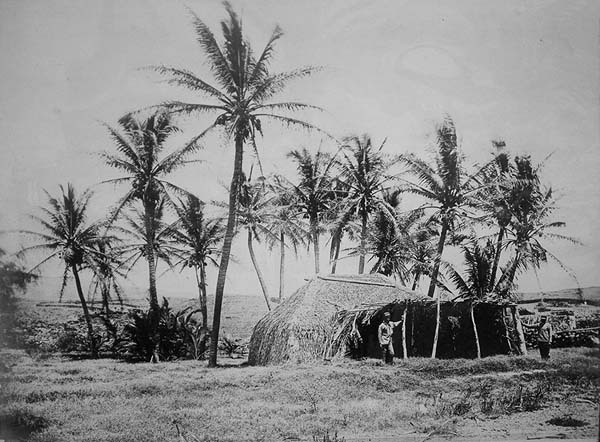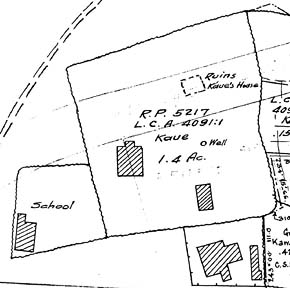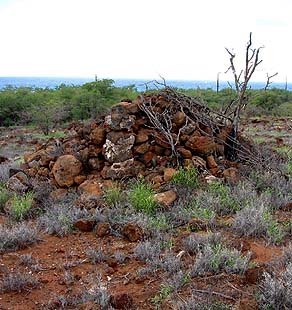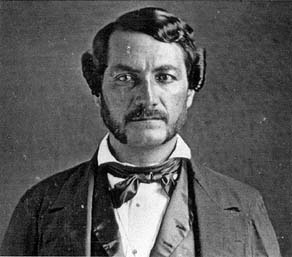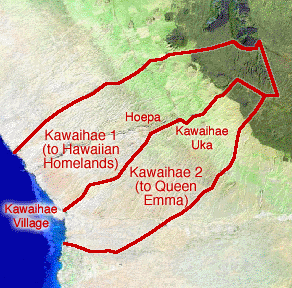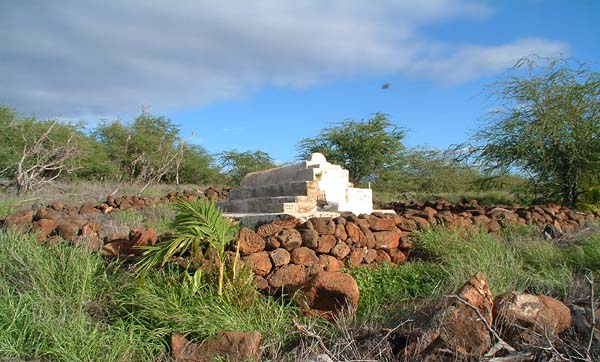 |
 |
 |
|||||
|
|
|||||||
|
|
|||||||
| |
|
|
|
|
“Hawaiians were ruled by the ali‘i,” Billy explains, “and his kuhina nui was the overseer for the ali‘i in the various areas. So a Hawaiian didn’t own any of his own property, he just lived on the chief’s land. And it wasn’t until King Kamehameha III and King Kamehameha IV started the Mahele that lands became available to the commoner. Before that, the commoner had nothing. “With the Mahele, I think Kamehameha III had the good intent to get the land into the hands of the maka‘aianana, the commoners who lived on the land. But they weren’t schooled properly so they didn’t have proper surveys done, so many didn’t get patents from the Land Commission. As a result, lands were improperly recorded, and they didn’t really have ownership of the place."
|
||
| |
||
“The total fourteen kuleana awardees in the ahupua‘a do not reflect the total population of Kawaihae,” Chiogioji & Hammatt agree (1997: 22): ‘They probably represent the local elite, those who could afford the survey and commutation [that were part of the award procedure], had the proper authority for permanent occupancy, had reputable witnesses to sustain both the authority [to occupy] and continuous use [of the parcel], and who chose to apply’ (Apple 1978: 62, cited in Chiogioji & Hammatt 1997: 22). “Many people watched for these lands that they knew they were not patented,” Billy points out, "and any time they saw such lands, they’d start paying taxes on them, and they went in and grabbed them. So the Hawaiians were duped out of a lot of land, in more ways than one. It’s sad."
|
|
|
“But it also made it possible for people like my great-grandfather William Johnson and other caucasians to purchase land also. However, he wouldn’t have been able to get as much land if it hadn’t been for his wife who was descended from ali‘i, and from Isaac Davis. It was two-way. So they were treated favorably. Just like John Palmer Parker who married to Princess Kipikane, he was able to get a lot. “Maybe some of those guys married with the thought in mind, ‘Hey, if I get that one she’ll be useful to me.’ Ha ha! "I’m thankful that the women in my family, the generation above my father, were strong women. They believed in the ahupua‘a. They believed in hanging onto these lands. That’s why these lands still go right up to the mountain. It’s come down for generations.”
|
|
|
|
Table of Mahele Awards for Kawaihae:
|
||||||
|
Claim |
Claimant |
Island |
District |
Ahuupua |
Ili |
Awarded |
|
00103B |
Kaukahi |
Hawaii |
Kohala, South |
Kawaihae uka |
Makila or Makala |
No |
| 00240O |
Kaahawi, Nika |
Hawaii |
Kohala, South |
Kawaihae |
Kaneloa |
Yes |
|
00240P |
Kaukahi |
Hawaii |
Kohala, South |
Kawaihae |
Makila |
Yes |
| 00595*H |
Rooke, T.C.B. for Young |
Hawaii |
Puna, Hilo, Kohala, Kona, N |
Kamano, Kukuihala, Waikahekahenui, Waikaheiki, Kukuwaunui, Kukuwauiki, Waikoloa, Waiakanui, Waiakaiki, Ouli, Kapaa, Waika, Kuokalani, Kawaihae, Hianaloli, Kaului, Pahahaeiki, Pahea, Kaepapa, Kalama, Kiilae, Kailua, Ohuowao, Hoowalehalawa, Koakui,&c |
|
No |
|
03668 |
Manuia, D |
Hawaii |
Kohala, South |
Kawaihae |
Koleaka |
Yes |
| 03669 |
Makahi |
Hawaii |
Kohala, South |
Kawaihae |
Pahonu |
Yes |
|
03826 |
Punihaniha |
Hawaii |
Kohala, South |
Kawaihae |
Kahapaakai |
Yes |
| 04091 |
Kaue |
Hawaii |
Kohala, South |
Kawaihae |
Kahapaakai |
Yes |
|
04094 |
Kepaimaka |
Hawaii |
Kohala, South |
Kawaihae |
Kaelepuhi |
Yes |
| 04101 |
Kahananui |
Hawaii |
Kohala, South |
Kawaihae |
Kanaio |
Yes |
|
04103 |
Kaahunaliiole, J.P. |
Hawaii |
Kohala, South |
Kawaihae |
Kahaleuku |
Yes |
| 04106 |
Kaui |
Hawaii |
Kohala, South |
Kawaihae |
|
Yes |
|
04522 |
Puna, Ioba |
Hawaii |
Kohala, South |
Kawaihae |
Pahukanilua |
Yes |
| 04882*H |
French, |
Hawaii |
Kona,North, |
Kawaihae, |
|
No |
|
04884 |
French, William |
Hawaii |
Kohala, South |
Kawaihae |
|
Yes |
| 08279 |
Kekoi, Stephen |
Hawaii |
Kohala, South |
Kawaihae uka |
|
No |
|
08513 |
Lincoln, Lorenzo B. |
Hawaii |
Kohala, Souith |
Kawaihae uka |
Keawewai |
Yes |
| 08515*H |
Keoni Ana |
Hawaii |
Kohala, South,Hilo |
Keahu, Kawaihae hikina, Kukuau |
|
Yes |
|
10232 |
Muia, Davida |
Hawaii |
Kona, North |
Kawaihae |
Kaholei |
No |
| 10903 |
Puna |
Hawaii |
Kona, North |
Kawaihae |
|
No |
|
10904 |
Manuia |
Hawaii |
Kona, North |
Kawaihae |
|
No |
“The mid-19th century distribution of the kuleana parcels along Kawaihae Bay within the two ahupua‘a may reflect the traditional pre-contact Hawaiian settlement pattern," Chiogioji & Hammatt suggest. "The shoreline of Kawaihae Hikina, dominated by the presence of the two heiau, may have been an enclave reserved for residences of the ali‘i and their retainers—as it was for Ka‘oana‘eha and the konohiki Puna in the 1840s. " "In contrast, to the north at the Kawaihae Komohana shoreline, the maka‘ainana (commoners) would have lived and worked amidst the salt pans, and, likely, the ‘excellent’ canoe houses that George Vancouver observed in 1792. The two claims for mauka awards of cultivated land in Kawaihae Hikina may be the surviving remnants of a once much larger, agriculture-based, upland settlement in the ahupua‘a” (Chiogioji & Hammatt 1997: 25).
|
||
| |
||
“Although there were many Hawaiians living in Kawaihae Uka about 1850," Langlas writes, "there were almost no mahele awards made there. Hawaiians continued to live there after the mahele probably as tenants of the ahupua‘a owners. The eventual disappearance of Hawaiians from Kawaihae Uka is related partly to its land history. Kawaihae 2 went to Keoni Ana [John Young's heir] in the mahele and subsequently was inherited by his niece Queen Emma. "Two small houselot awards were made in mauka Kawaihe 2 in the mahele, but the properties have been taken over by the Queen Emma Foundation today as part of their larger property. No Hawaiians have family land there anymore."
|
|
|
“Kawaihae 1 went to the crown in the mahele. There was only one mahele award made there. The land of Keawewai (520 acres) went to the white settler Lorenzo B. Lincoln. Lincoln had been given the land by Governor Kuakini in 1839 for his services to Kuakini in tanning the hides of the cattle which were running wild in Waimea. “The crown land of Kawaihae 1 became Government land after Hawai‘i was annexed by the U.S. and it was given to the Department of Hawaiian Home Lands (DHHL) after the 1920 Hawaiian Homes Act, for homestead leases to Hawaiians. Since then, the great bulk of Kawaihae 1 (except for Keawewai and the land at Kawaihae Bay) had been leased to Kahua Ranch for running cattle” (Langlas 1994: 18). The lower portion has recently been developed as house lots for Hawaiians.
|
|
|
|
|
“Codified in Kingdom law were provisions such that tenants and landlords were directed to have duly respectful relationships with one another," Hannah points out. "Landlords were not to abuse their tenants, and tenants were to maintain good behavior on their lands. I think that through the Kingdom period, the traditional landlord-tenant relationship was preserved. "This is of course is what’s still being argued in the courts of the State of Hawai‘i: What are traditional and customary rights? What rights do tenants have? How do those provisions for rights accruing to tenants become practiced today when resources have been depleted, and maybe tenants from one ahupua‘a no longer have resources that are found in other ahupua‘a? Is it then permissible to go to other ahupua‘a to extract or utilize those resources?"
|
||
|
|
||
| The legacy of the Mahele certainly transformed the fabric of the islands ever since. For the rest of the 19th century and on, private ownership of would affect population and society in Kawaihae.
|
||
|
|
||
|
|
|
|
|
|

|
| Kawaihae Home | Map Library | Site Map | Hawaiian Islands Home | Pacific Worlds Home |
|
|
|
|
|
|
|||
| Copyright 2006 Pacific Worlds & Associates • Usage Policy • Webmaster |
|||
